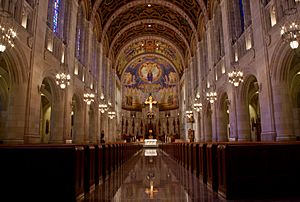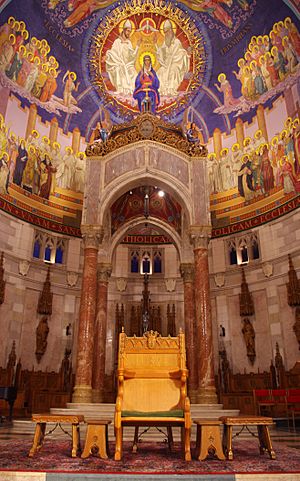Rosary Cathedral (Toledo, Ohio) facts for kids
Quick facts for kids Our Lady, Queen of the Most Holy Rosary Cathedral |
|
|---|---|
 |
|
| Location | 2535 Collingwood Boulevard Toledo, Ohio |
| Country | United States |
| Denomination | Roman Catholic |
| History | |
| Founder(s) | Samuel Stritch |
| Dedicated | October 1940 |
| Architecture | |
| Architect(s) | John T. Comes original design William Perry supervising architect |
| Administration | |
| Diocese | Toledo |
Our Lady, Queen of the Most Holy Rosary Cathedral is a beautiful Roman Catholic church in Toledo, Ohio. You can find it at 2535 Collingwood Boulevard in the Old West End area. This amazing building was finished in 1931. It serves as the main church for 122 other Catholic churches in the Toledo area.
People say this cathedral was designed to look like buildings in Toledo, Spain. It's special because it's the only church in the U.S. built in a style called Spanish Plateresque. This style is known for its many fancy stone carvings.
Contents
History of the Cathedral

The cathedral was designed by an architect named William Perry from Pittsburgh, Pennsylvania. His plans were approved by Samuel Stritch, who was the second bishop of the Toledo diocese.
Construction began in 1925, and the first stone was laid in 1926. The main structure was completed in 1931. This was during a tough time called the Great Depression. The whole project cost about $3.25 million. The church was officially dedicated in October 1940 by Karl Joseph Alter, the third bishop of the diocese. It was named Our Lady, Queen of the Most Holy Rosary Cathedral.
Amazing Architecture
The cathedral has a basilica floor plan, which means it's long and rectangular like many old churches. It's built from strong Massachusetts granite with special Indiana limestone details.
The front of the church has one main entrance. It's set back inside a curved arch with detailed limestone carvings. Above the doorway, there's a statue of the Virgin Mary in a carved space.
The Rose Window
Above the statue, you'll see a large round window called a rose window. It's about 28 feet (8.5 meters) across. This window shows scenes from Mary's life. It was paid for by children throughout the diocese who donated pennies!
On either side of the entrance, there are two tall, eight-sided towers. These towers have carvings of important saints, Peter and Paul. Above the rose window, at the very top, you can see the diocese's official symbol. A long carving, called a frieze, goes all around the outside of the church. It shows important events from church history.
Inside the Cathedral
The main part of the church, called the nave, has a curved ceiling. This ceiling is divided into seven sections. Each section is beautifully painted with figures from both the Old and New Testaments by an artist named Felix Lieftuchter. These paintings use special mineral paints that don't fade and don't affect the church's sound.
Each section of the ceiling also has three tall windows. These windows are about 26 feet (7.9 meters) high and 8 feet (2.4 meters) wide. Along the nave, there are smaller altars dedicated to St. Theresa of Lisieux and Our Lady of Perpetual Help.
The main altar is made from black marble imported from Spain. The pulpit, where sermons are given, is carved from white oak wood by a German artist. Around the curved end of the church, called the apse, there are statues of the eight writers of the New Testament. Each statue stands under a carved spire.
The Ernest M. Skinner Organ
The cathedral is home to a very large pipe organ made by Ernest M. Skinner in 1930. This amazing instrument has 75 stops and 76 sets of pipes, totaling 4,916 pipes! These pipes range in size from just 7 inches (18 cm) to over 32 feet (9.8 meters) long.
The organ was personally finished by Ernest Skinner himself. It was officially dedicated in 1931 by Palmer Christian, a professor from the University of Michigan. Experts say this organ shows the best of Skinner's work.
This organ is still almost exactly as it was when it was first installed. It's considered one of the most important musical treasures of the cathedral and the city of Toledo. In 2009, it received a special historical award from the Organ Historical Society. There's a similar organ in the concert hall at the Toledo Museum of Art.
Restoration Work
In 2000, the church finished a big project to restore the inside of the cathedral. They cleaned away years of soot from old heating systems. This brought back the original bright colors and shine of the beautiful mosaic artworks.
In the 2000s, the church also improved the outdoor areas. They re-landscaped the grounds and replaced the paths leading to the entrances. The new paths match the style and color of the stone on the building. Around the same time, the parking lot got new gates and stone decorations that also matched the church's design. The church even bought another parking lot across the street.
Cathedral Dimensions
- Total Length: 285 feet (87 meters)
- Total Width: 215 feet (66 meters)
- Height from floor to peak: 96 feet (29 meters)
- Normal Seating: 1400 people
- Rose Window: 28 feet (8.5 meters) in diameter
- Tabernacle height: 5 feet (1.5 meters)
People Connected to the Cathedral
- Claude Lagacé, who was the organist at the Rosary Cathedral from 1954 to 1961.
See also
 In Spanish: Catedral de Nuestra Señora Reina del Rosario (Toledo) para niños
In Spanish: Catedral de Nuestra Señora Reina del Rosario (Toledo) para niños
- List of churches in the Roman Catholic Diocese of Toledo
- List of Catholic cathedrals in the United States
- List of cathedrals in the United States
- Churches Named for the Rosary




